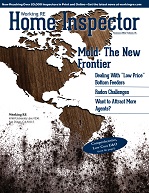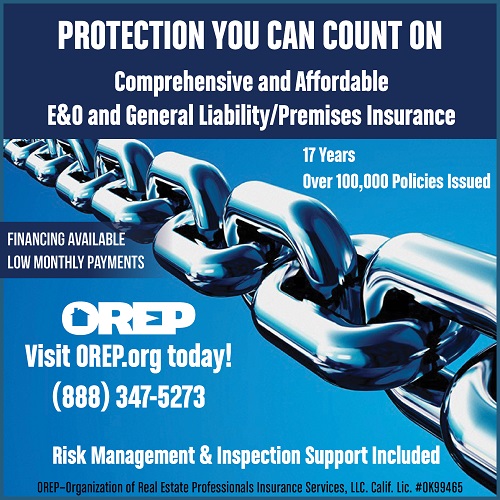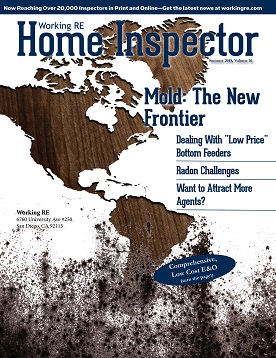 |
> E&O/GL Insurance for Home Inspectors Competitive Rates, Broad Coverage, Free Risk Management, online inspection support for tough questions, discounts on education and more… Professional Coverage, Competitive Pricing Shop OREP today! |
Addressing the Radon Challenges in Home Inspection
by Bruce Snead, Kansas State University
The challenge of addressing radon in home inspection will continue to grow as states pass radon specific disclosure laws and may expand dramatically and quickly if federal housing finance entities adopt radon testing and mitigation requirements. The Engineering Extension at Kansas State University, as a provider of national public radon technical assistance for the U.S. EPA since 2009, has processed more than 100,000 inquiries about radon. The range of questions and queries has been interesting, to say the least, and has led us to designing our website: sosradon.org —to address the most frequent questions.
We often find ourselves in a conversation among citizens, buyers and sellers, home inspectors, mitigators and real estate agents. Our goal is to provide an unbiased and practical source of information for everyone on all sides of the conversation, sharing EPA and state guidance, access to certified measurement and mitigation professionals, and assisting callers in understanding and reducing their risk of radon exposure. As one of the original 1980s EPA regional radon training centers, we have trained thousands of inspectors and mitigators. These folks are achieving real radon risk reduction and saving lives by testing, fixing, and building radon-resistant structures. Helping radon professionals with real world testing and mitigation quandaries is also a frequent task of our radon technical assistance, and we share and receive lessons learned from these interactions with both the professional community and the public.
While some real estate agents and inspectors think that radon testing is required (which is not a bad thing), it really is only required in Montgomery County, Maryland, in rental housing in Maine, and in some HUD financed multi-family projects. In many locations, especially those states and areas with higher radon potential, radon testing is standard procedure, even though it is not required by law. Unfortunately, in many other locations, agents may say, “radon is not a problem in our area,” which, of course, is not true and leads to a lack of testing and recognition of the risk posed by long-term exposure to elevated radon levels.
(story continues below)
Regardless of the views of the participants in real estate transactions, it is critical that home inspectors conduct appropriate and accurate radon measurements so that clients have a sound basis for the mitigation decision negotiation. That means following quality assurance steps and conducting quality control measurements to assure all clients that results are valid and representative of the potential for elevated radon in the home tested. It would be wonderful if protocols and standards provided answers to all the test placement challenges encountered in the field, but that is not the purpose of those standards. Professional judgement will always be at play; documentation of placement decisions and interpretation of results are part and parcel of every measurement.
Radon test results (especially when 4.0 or more) are often challenged as non-representative for any number of reasons. It is crucial that the testing professional evaluate the results, and if determined to be valid and substantiated, stand behind the results without casting doubt on the measurement. Annual calibrations, duplicates and cross checks are fundamental to assuring quality measurements. Conducting a second measurement should be avoided as much as possible; there should be no reason to doubt the first. There is uncertainty in every measurement. The proper protocols outline what we can do to minimize that: maintaining closed house conditions in our short-term measurements, among them, and following device operation and placement instructions. What happens to the house during the test has far more influence on the results than the specific device used to conduct the test. This is why tests must be a minimum of 48 hours with closed house conditions 12 hours prior to test start, or tests must run four days or more after closed house conditions are in place. We do all we can to provide reliable results but we know that the natural variability of radon may lead to a result of 3.9 for this sale, and a result of 4.1 when the house sells a year later.
State and industry members working together for increased radon awareness led to the passage of specific radon disclosure requirements in Illinois and Minnesota. This has resulted in dramatic increases in testing and mitigation activity. While the holy grail of radon legislation would be required testing in every home sale, it is not likely to be achieved anywhere soon. State radon programs and the EPA appropriately seek increased radon awareness, and Congress has provided guidance with an emphasis on outreach to physicians and schools. But efforts to influence HUD and federal housing radon policy may present the greatest opportunity for home inspectors. Were those agencies to require radon tests in all their associated housing transactions, the demand for testing and mitigation services could outstrip industry capacity. Areas of the country where radon potential is low but frequency of real estate transactions are high would experience the most significant change in radon testing and need for testing and mitigation services.
While there is no “safe” level of radon, the goal is radon levels as low as reasonably achievable. When testing results lead to mitigation, properly installed systems have proven capable of reducing any level of radon to below 4 and in most cases below 2. The key word is “properly installed,” which means according to the mitigation standard adopted in a certifying state where the house is located, or the standard the National Radon Proficiency Program or National Radon Safety Board certified mitigator has agreed to follow. In regulated and non-regulated states alike, systems may be installed by those who are untrained, ignorant, or willing to do a “least cost” system that may have negative effects on radon levels, air quality, and energy use.
A review of regulating states will reveal numerous mitigation checklists, and it is important to access the state checklist as a reference when working in that jurisdiction. The American Society of Home Inspectors has also just completed its own comprehensive mitigation system inspection checklist with 69 items. If your state does not offer its own checklist, it is an excellent resource for safety and compliance, with the minimum national standards. Our continuing education mitigation system inspection courses use this and several other checklists to review case studies and in field systems, as well as hall of fame and hall of shame examples from across the country.
As inspectors encounter field testing and mitigation challenges, National Radon Program Services at Kansas State University is available to respond to you and to help resolve situations based on practical knowledge and experience. Our website is sosradon.org and the national radon helpline number is (800) 557-2366. We can also be reached at radon@ksu.edu for assistance. Please don’t hesitate to call if we can be of service.
Free Risk Management Online Course Claims and Complaints: How to Stay Out of Trouble
Available Now
Presenter: David Brauner, Senior Insurance Broker OREP
David Brauner, Senior Broker at OREP, shares insights and advice gained over 25+ years of providing E&O insurance for inspectors, showing you how to protect yourself and your business. Watch Now!
About the Author
Bruce Snead has been a state extension specialist in residential energy, radon and indoor air quality at Kansas State University since 1982. He has conducted radon industry training since 1989, and directs the Midwest Universities Radon Consortium at KSU, with the potential to serve 33 states. Bruce has also led K-State’s role in the Kansas Radon Program for twenty-eight years, and has led the National Radon Program Services effort for EPA since 2009.
Note: The Summer 2019 issue of Working RE Inspector is mailing now to over 20,000 home inspectors nationwide. OREP Insureds enjoy guaranteed delivery of each print magazine and many more benefits.
OREP Appraiser E&O insureds enjoy it free and this year Free Approved Continuing Education!!




by Radon Testing and Mitigation PNW
This is a helpful guide for enhancing safety during home transactions.
-by Wichita Radon
The practical tips and strategies provided can really help improve the accuracy and reliability of radon assessments in homes.
-by Wichita Radon
Since radon levels vary from day to day so be sure to check your radon levels at least annually.
-by Chris
Wow I can’t believe how dangerous radon is. Growing up I never even knew what radon was. It is not talked about that much and now that I am in Colorado it is actually very high risk here. When I moved into my new home they had told me about the dangers of radon and so we did some searching for a company and they tested our home and our levels were actually in the danger zone which was scary. Thanks to them we can feel safe.
-by Luke Smith
I love that you explained how EPA and state guidelines are doing their best to test, fix, and build radon-resistant structures. I’d assume that future skyscraper owners want their infrastructure to be built as firm and as calamity-proof as possible. I’d recommend hiring a radon mitigation service to those building owners so that they can discuss their plans and apply the suitable radon service to the buildings.
-by Thomas Peterson
You made a good point that there really is not a “safe” level of radon but the goal is to have it as low as possible. I recently moved into an area where radon can be apparent and I have been trying to do my research on it. Maybe I should get in touch with a radon mitigation service and see how that helps me.
-by Jeremy Hall - Colorado
As we build homes with better energy efficiency and retrofit older units with modern items and function corrections, the air exchange rate within living areas of a home decreases. It’s true that radon never used to be much of a problem for older homes, air exchange rates were robust. New and refurbished homes contain more toxicity with such reductions in air exchange. The safety industry is so far behind. What would be said if they tested buildings for off gassing compounds from insulation, engineered (glue) components, plastic components, fsc’s and other complex chemicals routinely found in modern items. The glorious smell of foam and fsc’s, months and years after application. If you’re worried about radon, leave a window cracked. If you need insulation, choose a material which does not require fsc’s. If you’re worried about chemicals and off gassing, use solid woods, copper, steel, and iron, avoid plastic, avoid engineered glue based components, avoid fsc’s. If you need an energy efficiency boost, swap out siding material and use smart landscaping to protect from the sun. Radon is a give me, everyone has some problem that could be identified but the solutions to mitigating that do not require fancy equipment, testing, or government intervention. Radon is the easy focus target because there is no manufacturing giant with lobbyists in government whom produces this naturally occurring gas. There are more important things to be worried about than radon.
-